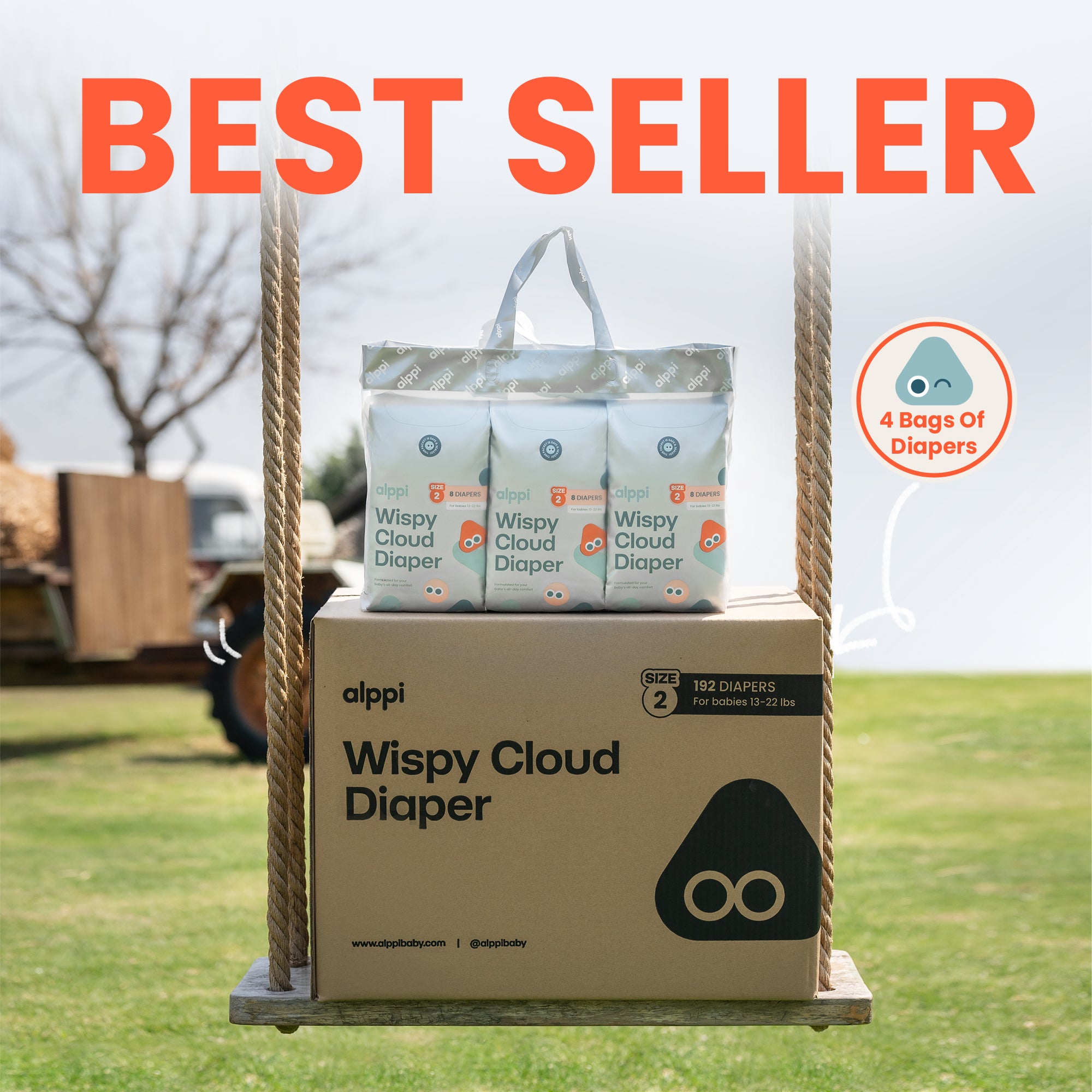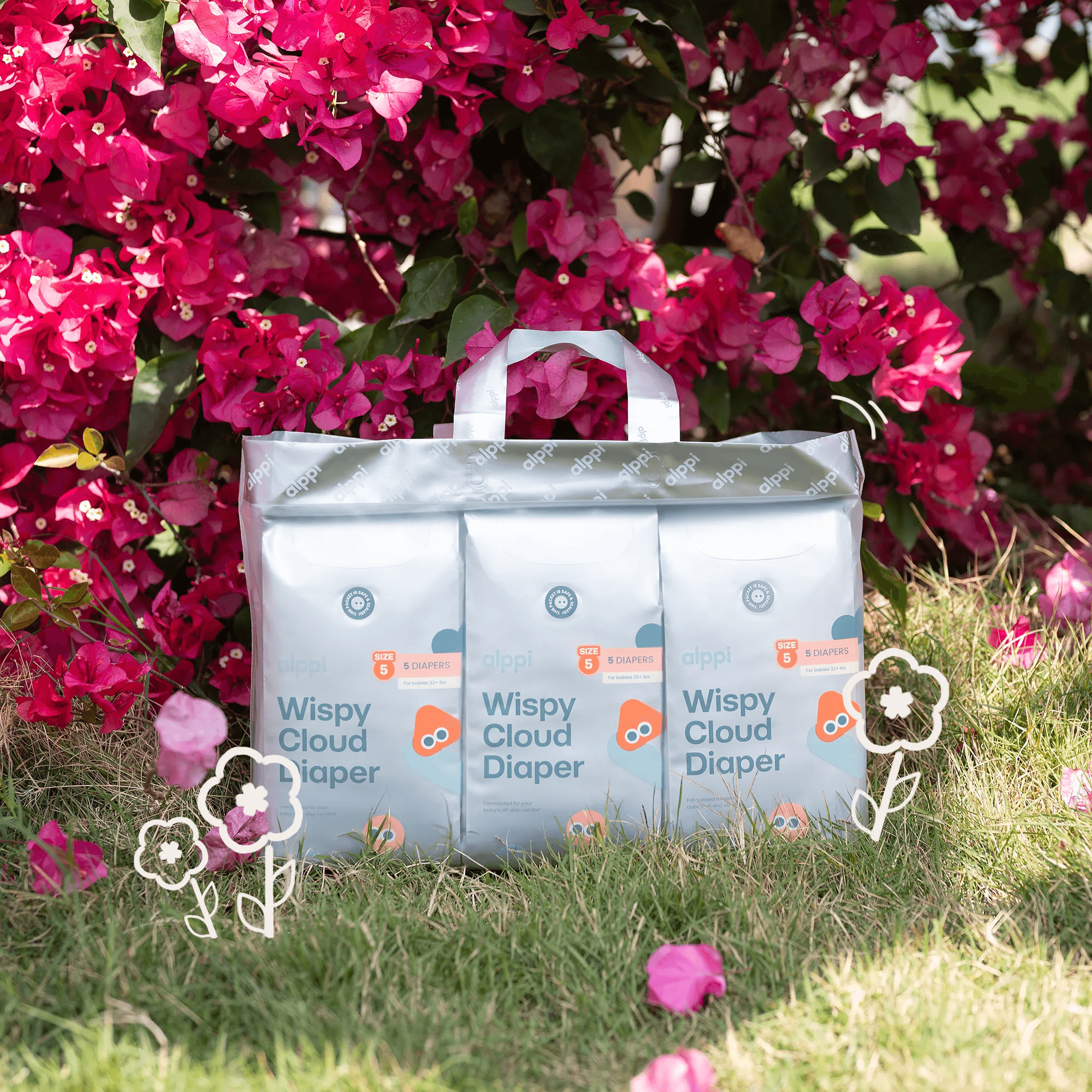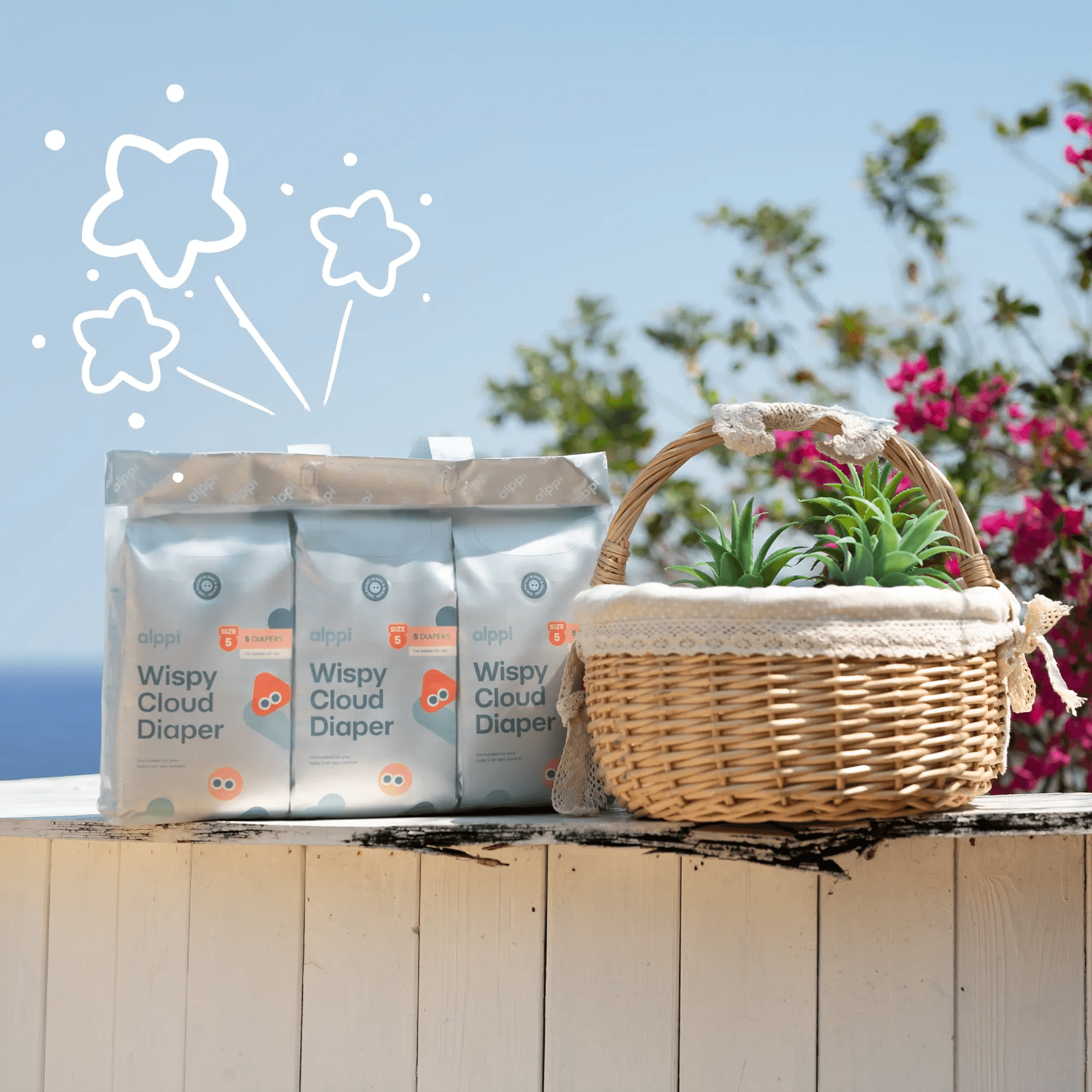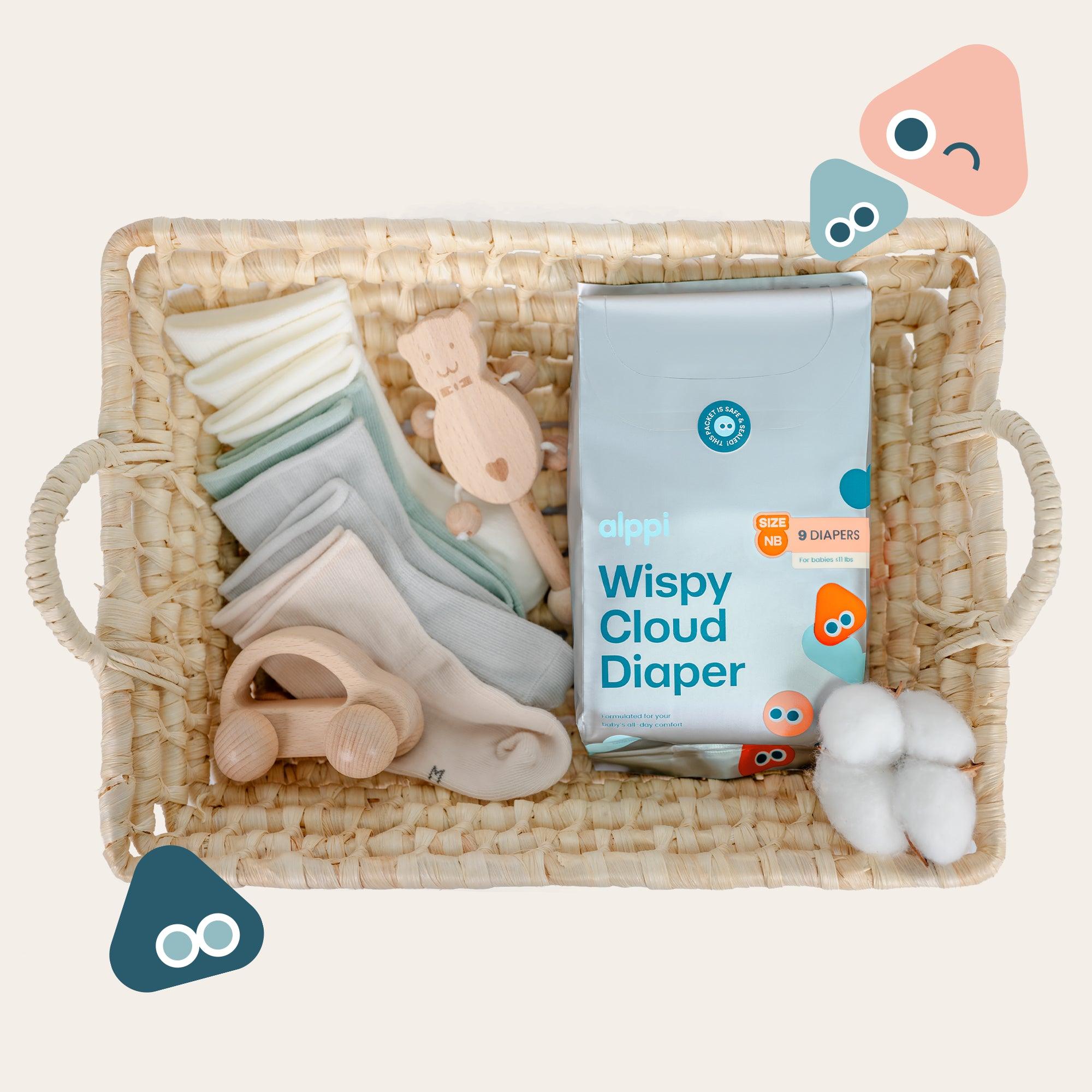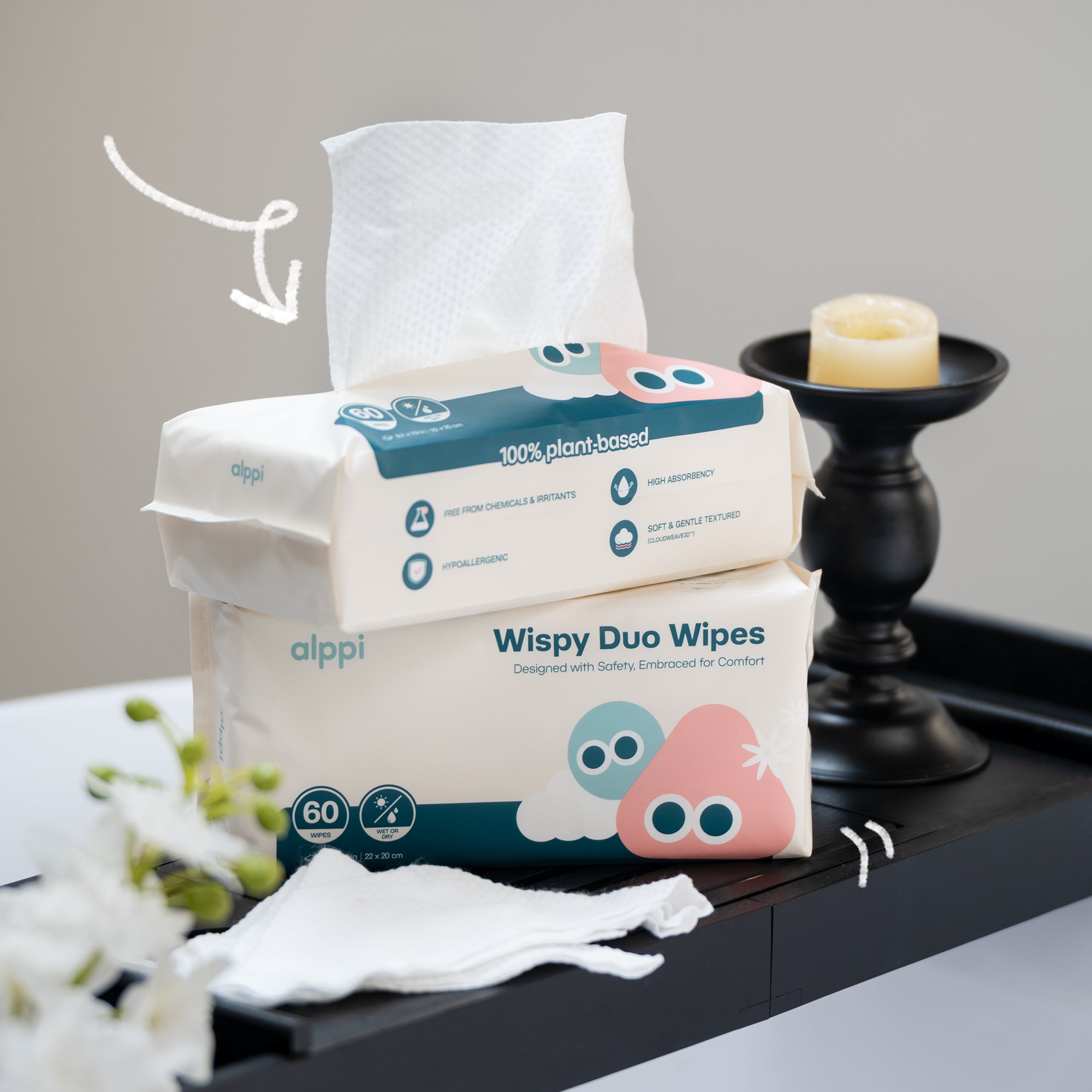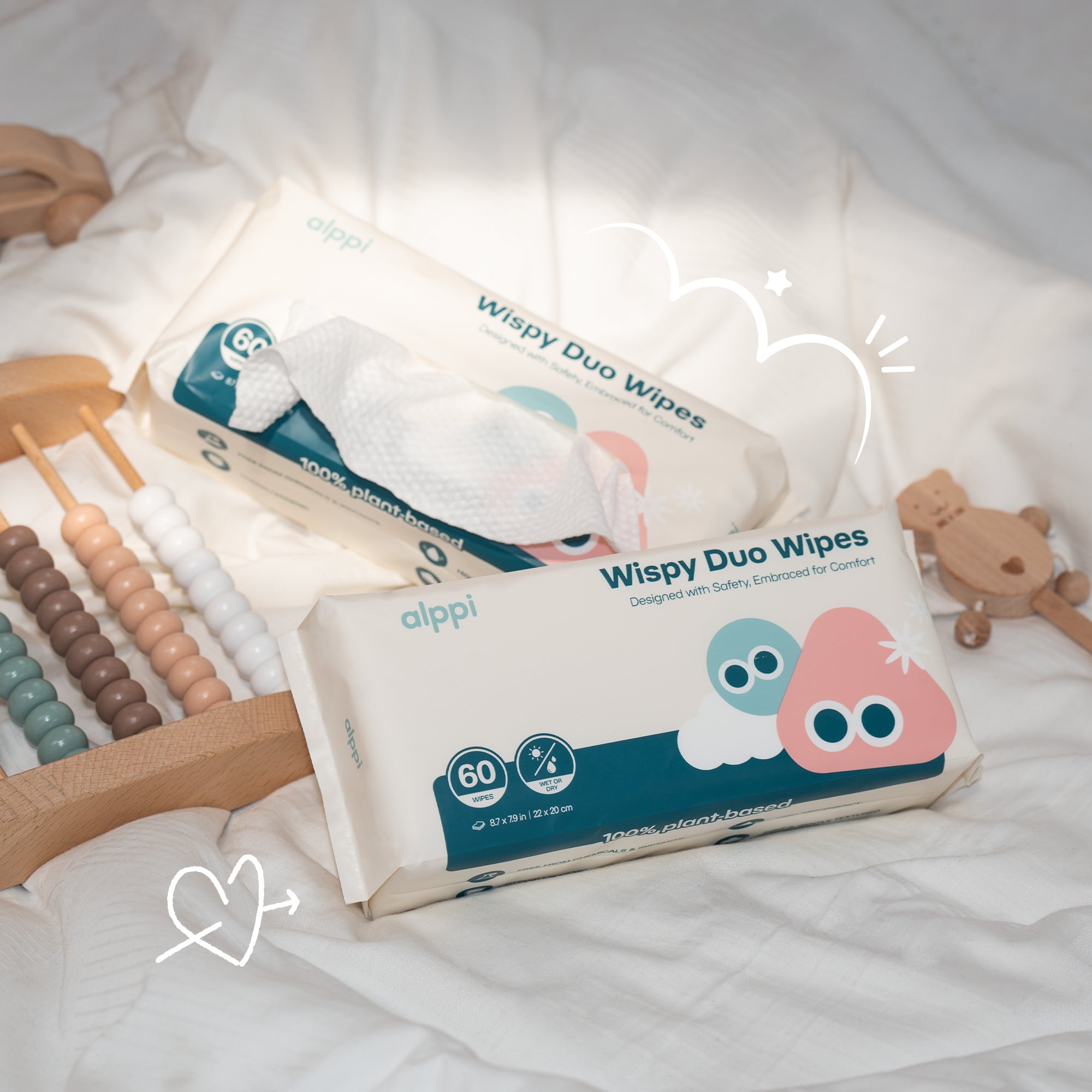By six months, most babies become more mobile, often rolling over in both directions and sitting with some support. Their motor skills improve, letting them reach out and move objects from one hand to the other.
Socially, they begin to recognize and respond to their name, show excitement when seeing familiar faces, and enjoy playful interactions. Communication also takes a leap forward, with babies babbling using a mix of consonants and vowels, giggling, and even blowing raspberries as they experiment with sounds.
This stage is when many babies try solid foods for the first time. You’ll notice stronger head control and your baby might start to recognize familiar faces.
Your 6 month old may even respond to their name or enjoy simple games like peek-a-boo. These skills show progress in physical, social, and cognitive development.
Read our guide: Do Diapers Expire and How to Store Them Properly to learn how to keep essentials fresh and ready.
Why 6 Month Old Milestones Matter

At six months, your baby moves through key developmental milestones. These skills show growth in movement, communication, and social interaction.
Watching these changes helps you spot your baby’s growth patterns. Sometimes, you can see if your baby needs extra support in a certain area.
Tracking milestones helps you understand what your baby is ready for. For example, when your baby can sit with some support, it might be time to try new play activities or feeding options like purees.
Your doctor checks these milestones to track your baby’s health and progress. Sharing what your baby can do—like rolling, reaching, or babbling—helps the doctor get a clear picture.
Here are a few reasons milestones matter:
- Early detection: Delays can be noticed sooner.
- Guidance: You know what skills to encourage at home.
- Connection: You feel more confident about your baby’s progress.
You don’t have to compare your baby to others. Still, keeping track brings peace of mind.
Each baby grows at their own pace, but most follow similar patterns by six months. Even small steps, like reaching for a toy or turning toward your voice, show that your baby’s brain and body work together.
Physical And Motor Skills

By six months, your baby’s body control gets stronger. You’ll notice big changes in how they move and use their hands.
Rolling, Sitting, And Early Crawling Signs
Around this age, you’ll see your baby rolling from back to tummy and tummy to back more easily. Rolling is a big motor milestone and shows your baby is learning to control their core.
Many babies can sit with support, like leaning on their hands or with a pillow behind them. By the end of the month, some may sit for short times without help, though they might still wobble.
You might notice early signs of crawling. This could look like pushing up on arms, rocking on hands and knees, or scooting backward.
These movements help your baby build strength in their shoulders, arms, and legs.
Key skills at this stage:
- Rolling both ways
- Sitting with or without support
- Bearing weight on arms and legs during tummy time
Reaching, Grasping, And Hand‑To‑Mouth Play
Your baby’s hand-eye coordination improves a lot now. They reach out on purpose and grab toys, usually with a whole hand grip called the palmar grasp.
Once they have something in their hand, you’ll see them bring it to their mouth. This is how they explore textures and shapes, and it helps with teething, too.
Babies at this stage often pass objects from one hand to the other. That shows they’re gaining control and awareness of both sides of their body.
They might also bang toys on surfaces, which helps them practice movement and strength.
Typical hand skills now include:
- Reaching directly for objects
- Grasping with the whole hand
- Passing items between hands
- Exploring by mouthing and banging objects
Read our article, Types Of Diaper Rash Pictures And How To Identify Them, and learn how to spot and soothe common rashes.
Communication And Social Growth

At six months, your baby starts to connect sounds, faces, and feelings in new ways. You’ll see more back-and-forth interaction and clearer vocal play.
They also show stronger emotional responses to both familiar and new people.
Babbling And Responding To Voices
By this age, your baby usually moves past simple coos and starts babbling. You’ll hear sounds like “ba,” “da,” or “ma” repeated in a row.
This is a key language milestone because your baby is practicing the building blocks of speech. When you talk, your baby may pause, smile, or make a sound back.
This early “conversation” helps them learn turn-taking, which is an important social skill. Babies notice changes in your tone, so using a warm, playful voice can encourage more responses.
Try simple activities to support language development:
- Repeat the sounds your baby makes.
- Use short, clear words during play.
- Sing or read in a calm, steady rhythm.
Smiles, Laughter, And Stranger Awareness
Social and emotional growth shows up through smiles and laughter. At six months, your baby often laughs when you play peek-a-boo or make silly faces.
This joy is part of their emotional development. You might notice stranger awareness too—your baby could cling to you or look cautious around new people.
This is a normal emotional milestone that shows your child recognizes familiar caregivers and feels safest with them.
Encourage comfort by:
- Holding your baby close when meeting new people.
- Letting strangers approach slowly.
- Offering a favorite toy for reassurance.
Discover the best routines in How Often Should You Change Your Baby's Diaper? A Simple Guide & Tips.
Cognitive Development At 6 Months

By six months, your baby’s brain grows fast. You’ll notice sharper attention and stronger memory.
They’ll show more interest in exploring the world. Everyday play becomes a way for your baby to practice problem-solving and build early pattern recognition.
Curiosity, Cause‑And‑Effect, And Focus
At this age, your baby starts to connect actions with outcomes. They might drop a toy on purpose just to watch you pick it up.
This is an early sign of cause-and-effect thinking. You’ll also see longer moments of focus.
Your baby may study your face, a toy, or even a pet with steady attention. This shows growing memory and stronger visual tracking.
Babies begin to notice simple patterns. They might recognize routines, like knowing a bottle means feeding time.
Ways you can support this:
- Offer toys that respond to touch or sound, like rattles.
- Repeat simple games, such as peek-a-boo.
- Keep routines consistent so your baby can predict what comes next.
Exploring Objects Through Touch And Taste
Your baby learns a ton by putting objects in their mouth. This isn’t just curiosity—it’s how they explore texture, shape, and even weight.
Touch and taste give them information their eyes can’t provide. They’ll grab toys, pass them from one hand to the other, and bang them on surfaces.
These actions help with problem-solving skills because your baby is testing how objects behave. You might see your baby comparing objects—maybe noticing that a soft stuffed animal feels different from a wooden block.
This is early pattern recognition.
Tips to encourage safe exploration:
- Offer clean teething toys and safe household items.
- Rotate toys so your baby experiences new textures.
- Stay close, since babies at this stage still put most things in their mouth.
Feeding And Sleep At 6 Months

At six months, your baby’s daily rhythm starts to shift. They may show signs they’re ready for solid foods, but they still need breast milk or formula as their main source of nutrition.
Sleep changes, too. You might notice longer stretches at night, but naps are still important.
Signs Of Readiness For Solids
By this age, your baby may show cues that they’re ready to try solids. They might be able to sit with little support, hold their head steady, and show interest in what you eat.
Some babies reach for food or open their mouth when a spoon comes near. The tongue-thrust reflex, which pushes food out, usually fades around this time.
This makes it easier for them to move food to the back of their mouth and swallow safely. Start with simple, single-ingredient foods.
Iron-rich choices like pureed meats, beans, or iron-fortified cereals help meet growing nutritional needs. You can also offer soft fruits or veggies, but avoid foods that are choking hazards.
Balancing Milk With First Foods
Even with solids, breast milk or formula should still be your baby’s main source of calories. At six months, most babies drink about 24–32 ounces of milk each day.
Solids are more about practice and learning than replacing milk feedings. Try offering solids once or twice a day after a milk feeding, not before.
This way, your baby gets the nutrition they need while exploring new textures and flavors. Introduce one new food at a time and wait 3–5 days before adding another.
This helps you watch for any reactions. Keep meals short and relaxed, and let your baby set the pace.
Typical Naps And Night Sleep Patterns
At six months, most babies sleep about 12–15 hours in 24 hours. This usually means 2–3 naps during the day and a longer stretch at night.
Some babies can sleep 6–8 hours without waking. Night feedings may still happen, though.
You might notice changes in sleep, sometimes called a sleep regression. Things like teething, growth, or learning new skills can make babies wake up more at night.
A steady bedtime routine helps your baby settle down. Try a bath, feeding, and quiet time in a dark room to signal it’s time to sleep.
Keeping naps at about the same times each day helps too. Babies thrive on routines, even if you don’t stick to them perfectly.
Activities To Support Development

At six months, your baby learns best through movement, play, and connecting with you. Simple activities every day help build strength, language, and curiosity.
Tummy Time, Play, And Safe Exploration
Tummy time is still important now, even if your baby rolls both ways. It builds neck, shoulder, and arm strength, which helps with crawling later.
Lay a soft blanket on the floor and put a toy just out of reach. Babies will reach and pivot to get it.
Try safe floor play too. Let your baby sit with support or practice sitting up with pillows around them.
This builds core strength and balance. Hand them soft blocks, rattles, or textured teethers to grab and chew—babies love that at this age.
Let your baby explore safely. Clear a small area so they can roll and scoot without bumping into anything.
Babies love knocking down cups or banging toys together. These fun moments teach problem-solving and motor skills.
Quick ideas for play:
- Place toys in a circle so your baby turns to reach
- Use a mirror for visual engagement
- Offer toys with different textures for sensory play
Talking, Reading, And Interactive Games
Your baby will respond more to your voice now and might babble back with simple sounds. Talk to them often to help build early language skills.
Describe what you’re doing, name objects, and answer when your baby makes sounds. It might feel silly, but it matters.
Read together every day. Pick board books with bright pictures and simple words.
Babies love reading the same book again and again. Point to pictures and let your baby touch the pages.
Try games like peekaboo or pat-a-cake. These teach turn-taking and social connection.
Singing simple songs with hand motions helps your baby link sound with action.
Easy ways to support language:
- Use short, clear sentences
- Repeat words often
- Pause after speaking to let your baby “answer”
- Make eye contact while talking or singing
These small moments every day lay the groundwork for communication. They help your baby feel close to you and understood.
Learn how to support this stage in Nourishing Your Little One: A Complete Guide to Baby Feeding Options.
Red Flags To Watch For

At six months, babies usually move more, make sounds, and show better body control. If your baby isn’t doing these things, check in with your pediatrician.
Delays In Movement Or Sitting
Most six-month-olds can roll both ways, push up on their arms, and sit with a little help. If your baby still moves like a newborn or can’t hold their head steady, that’s worth noticing.
If your baby can’t sit with some support by now, that matters. Sitting shows they’re building muscle and balance.
If your baby always slumps or can’t stay upright for even a few seconds, mention it at your next appointment.
Watch how your baby uses their arms and legs. Babies should kick, reach, and grab things.
If your baby doesn’t move much or seems weaker on one side, talk to your pediatrician. Sometimes these are early signs of a motor delay.
No Babbling Or Response To Sounds
By six months, babies usually babble with sounds like “ba” or “da” and respond to voices. If your baby is very quiet or doesn’t react when you talk, clap, or call their name, pay attention.
A baby who doesn’t turn toward familiar voices or loud noises may not be hearing well. Sometimes it’s just fluid in the ears, but it’s worth checking.
Communication at this age isn’t about words—it’s about showing interest in sound and people. If your baby doesn’t coo, laugh, or try to copy noises, bring it up with your doctor.
Stiff, Floppy, Or Uneven Movements
Muscle tone is a big deal at six months. Babies should feel steady when you hold them, not too stiff or floppy.
If your baby’s body feels unusually rigid or limp, this could mean a muscle or nerve issue.
Watch for uneven movements. If one arm or leg moves much less than the other, or if your baby always tilts to one side, that’s not typical.
Other signs include clenched fists most of the time, legs that stay very stiff, or a baby who seems uncomfortable when moving. Let your pediatrician know if you see these things.
Support Your Baby’s Growth with Alppi Baby
As your little one reaches exciting milestones at six months—rolling, sitting, babbling, and exploring—you want products that support their comfort and well‑being every step of the way. Alppibaby makes that easier with their thoughtfully designed weekly and monthly diaper boxes and gentle wipes.

Choosing Alppi Baby means you’re giving your baby:
- Comfort for every milestone – soft, hypoallergenic diapers that protect delicate skin while your baby learns to move and play.
- Dryness and confidence – highly absorbent diapers that keep your baby comfortable through tummy time, naps, and longer nights.
- Clean care made simple – premium wipes that are gentle but effective, perfect for everyday messes.
- Convenience for parents – flexible subscription boxes delivered to your door, so you can spend more time enjoying your baby’s growth.
- Eco‑friendly peace of mind – diapers made with sustainable practices, supporting both your baby and the planet.
With Alppi Baby, you’re not just buying diapers and wipes—you’re choosing a partner that helps you focus on what matters most: celebrating your baby’s milestones with comfort and care.
Final Thoughts
At 6 months, your baby is hitting milestones that show real progress in movement, communication, and social skills. From rolling over and sitting with support to babbling and recognizing familiar faces, each step builds the foundation for future growth.
While every baby has their own timeline, these milestones give you a helpful guide to track development and celebrate achievements.
If you notice delays, talk with your pediatrician for peace of mind. For now, enjoy this fun stage — your baby’s 6 month old milestones are filled with smiles, laughter, and new discoveries that make each day exciting.
For more support, check out Finding Your Parenting Style: A Guide for New Parents.
Frequently Asked Questions on 6 Month Old Milestones
How can I support my 6-month-old's emotional and social development?
Spend time face-to-face with your baby. Smile, talk, and answer when they make sounds or gestures.
This back-and-forth helps them feel safe and teaches them how communication works. Routines like feeding, bedtime, and play also help your baby feel secure.
Babies at this age often recognize familiar people and might show excitement or shyness. Comforting them builds trust.
What are some engaging activities to help my 6-month-old baby's growth?
Give your baby safe floor time to practice rolling, sitting up with support, and reaching for toys. Simple games like peek-a-boo or clapping help with social and motor skills.
Offer toys that make sounds, have different textures, or are easy to grab. These boost hand-eye coordination and curiosity.
How should a 6-month-old baby be communicating, and what signs of language development are there?
By 6 months, babies usually respond to their name, turn toward voices, and make vowel sounds like “ah” or “oh.” Some will start mixing sounds like “ba” or “da,” though real words come later.
Watch how your baby reacts when you talk. Smiling, cooing back, or trying to copy sounds all show healthy language growth.
What feeding milestones are important for a 6-month-old infant?
Most babies get curious about solids around 6 months, but they still need breast milk or formula. You might catch them eyeing your food, or maybe they’ll sit up with some help.
If they open their mouth for a spoon, that’s a good sign. Try smooth foods first, like pureed veggies, fruits, or iron-fortified cereal.
Take it slow. If your baby turns their head away or shuts their mouth, they’ve probably had enough.



